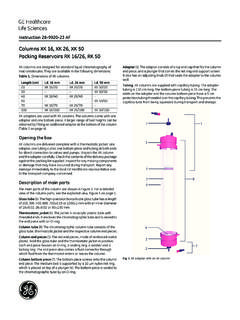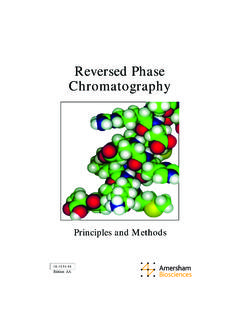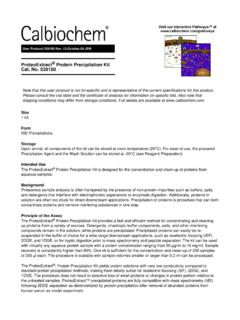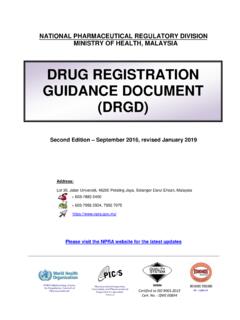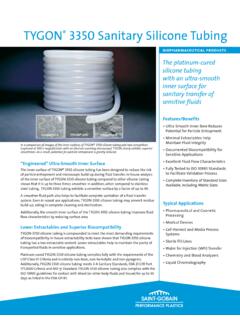Transcription of Protein analysis with size exclusion chromatography (SEC)
1 Protein analysis with size exclusion chromatography (SEC)Fundamentals. New-generation agarose resins. wk2 wk4 wk5004003002001000102 Retention time (min)A220 nm (mAU)4 time (min)A220 nm (mAU) wk2 wk4 wk2 KA790151217 WPIntroduction to Protein analysis with SECS ince the introduction of biologic-based therapeutics, the need for checking the presence of Protein aggregates has been of particular concern given their potential effect on efficacy and immunogenicity. SEC is a very effective method for Protein analysis and it allows true size profiling of Protein samples due to the mild separation conditions that can be used to obtain high-resolution separations. This is a great advantage compared to other size -separation techniques, such as ultrafiltration or dialysis.
2 A Protein can occur in different size forms (monomeric, aggregated, degraded, complexed, Fig 1) and those different forms exhibit different functions. As many Protein size forms are held together by noncovalent means, they are often weak and could be easily broken if using nonnative ( , denaturing) conditions. Factors to consider when selecting an SEC column for Protein analysisWhen choosing SEC columns for Protein analysis many parameters need to be considered with resolution being one of the most important. Resolution is influenced by several factors including: Resin properties Resin chemical composition Particle (bead) size and size distribution Pore size and selectivity Fractionation range Column related factors Running conditions Sample volume and injection technique Buffer composition Flow rate LC system configuration Tubing diameter and flow path volumeAfter the selection of SEC resin, column dimension and sample volume are the two factors that affect the resolution of the separation the 1.
3 Schematic illustration of different size forms of a analysis with size exclusion chromatography (SEC) size exclusion chromatography (SEC) is currently the most powerful chromatography technique for obtaining reliable information about the size of biomolecules under native conditions. As such, it is widely used in several different analytical applications from basic research to quality control of biotherapeutics. This white paper presents fundamentals about analytical SEC and describes how our new-generation agarose-based SEC columns are used in analysis of proteinAggregated target proteinComplexedtarget proteinDegradedtarget proteinOther proteins or contaminantsThe use of SEC makes it possible to size profiling the sample, for example when you need to: Monitor Protein prep quality Evaluate Protein stability Study complex formation Evaluate tendency to aggregate and quantity of aggregates Evaluate tendency to degrade and quantity of degraded forms Identify Protein interaction partners and interaction conditionsKA790151217WP 3 Fig 2.
4 (A). Fractionation range of globular proteins and peptides of various molecular weights on Superdex 30 Increase 10/300 GL, Superdex 75 Increase 10/300 GL, Superdex 200 Increase 10/300 GL, and Superose 6 Increase 10/300 GL prepacked chromatography columns. Note that the whole fractionation range of Superose 6 Increase is not covered in this diagram. (B). Zoomed image clearly shows the differences in selectivity between Superdex 30 Increase and Superdex 75 Increase propertiesResin chemical compositionDifferent resin types are available today, such as agarose, silica, and metacrylate. Silica-based and agarose-based resins are the two most used types of SEC resins for analytical purposes. For a comparison of both resin types, see Silica vs agarose size and size distribution Particle size is important for the resolution in SEC.
5 A rule-of-thumb is that smaller particle and narrow size distribution usually give the highest resolution. Particle size ranges used for analytical SEC currently available on the market including benefits and challenges are listed in Table 1. The size range of 4 to 12 m is traditionally the standard for analytical SEC resins. However, the trend is towards smaller particles of < 2 m, with the use of ultra high- performance liquid chromatography (UHPLC) systems for even faster separations in high-throughput mode. Columns packed with particles < 4 m in diameter typically provide rapid runs and high resolution. However, very high back pressures are generated when these columns are operated at high flow rates, often exceeding the pressure specifications of standard high- performance liquid chromatography (HPLC) systems.
6 Also, the LC system needs to have very small internal (dead) volumes so that the high resolution obtained over the column is not lost elsewhere in the flow. Keep in mind that the high pressure obtained under UHPLC conditions generates high temperatures and shear stress, which might affect sensitive proteins in particular (1 4).Table 1. Particle size ranges currently available for analytical SEC 4 to 12 m particles (standard for analytical SEC)< 4 m particles (includes particles for UHPLC)Benefits Usually provides adequate resolution and run times Standard HPLC equipment can be used Lower price for equipment compared with UHPLC Milder conditions can be used than with UHPLCB enefits Rapid runs High resolutionChallenges Very high back pressure; demands specific equipment Loss of resolution due to LC system dead volumes Heat generation and shear stress at high flow rates could affect proteinsPore size and selectivityPore size is a complex function of the pore diameter, the pore shape, the number of pores, and pore connectivity.
7 All pores are not equal even within a single chromatography particle. Describing the pore size of a chromatography resin with a single number such as average pore size is therefore an oversimplification. The relationship between resolution and selectivity for a SEC resin is described in the selectivity curve. The steeper the selectivity curve, the higher the resolution that can be achieved. Resolution is also affected by band-broadening, which is dependent on the particle size of the SEC resin. Fractionation rangeThe fractionation range defines the range of molecular weights of molecules that have access to the pores in the resin; molecules within this range can be separated by high-resolution fractionation. The exclusion limit for a SEC resin indicates the size of the molecules that are excluded from the pores of the resin and which therefore elute in the void volume.
8 In Figure 2, the fraction ranges of globular proteins and peptides with various molecular weights on the new-generation agarose-based resins can be (mL)Molecular weight (Mr)12171 000 000100 00010 000100010010 Superdex 30 IncreaseSuperdex 75 IncreaseMolecular weight (Mr 103)8007006005004003002001000 Superdex 30 IncreaseSuperdex 75 IncreaseSuperdex 200 IncreaseSuperose 6 Increase57911 Volume (mL)131517192123(A)(B)4 KA790151217 WPFig 3. Effect of increasing capillary inner diameter on resolution in Protein purification. Column-related factors The height of the packed bed affects both resolution and the time taken for elution. The efficiency in SEC increases with the square root of bed height (see formula below). Doubling the bed height gives an increase in resolution equivalent to 2 = (40%).
9 Column efficiency (N/m)= (Ve/W)2 LwhereVe = peak elution (retention) volumeW. = peak width at half peak heightL = bed height (m)Note that Ve and W. are in same unitsHowever, longer columns also mean longer run times. There is a tradeoff between resolution and runtime that needs to be defined by the needs for the analysis at hand. As the separation takes place in only one column volume, it is very important to have a well-packed conditionsSample volume and injection techniqueIn analytical SEC, the sample volume should be approximately of the bed volume to achieve optimal results. It is also relevant to consider how the sample loop (capillary) is filled and emptied, a factor that is often is overlooked. The sample assumes the shape of an arrow with a broad head and long shaft in its passage through the capillary, rather than the shape of a compact plug.
10 The sample therefore occupies a longer section of the capillary than expected, which can lead to a peak broadening effect. To ensure reproducible analysis , always ensure that the syringe is completely filled for manual injection. For autosampler injection, it is important to check the settings on how the injections are performed to avoid inconsistent compositionBuffers and sample are important parameters to achieve high resolution. The buffer composition and how it affects resolution will be discussed later in the document. Flow rateOne of the most important parameters that affects resolution is the flow rate (especially for large proteins). If the analysis shows low resolution between Protein peaks, the first action should be to set a lower flow rate for the chromatography system configurationTubing diameter and flow path volumeThe configuration of the liquid chromatography (LC) system needs to be optimized to achieve the highest resolution.
